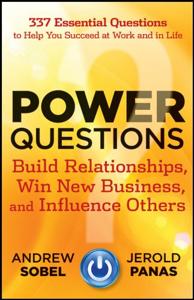
Want to learn the ideas in Power Questions better than ever? Read the world’s #1 book summary of Power Questions by Andrew C. Sobel, Jerold Panas here.
Read a brief 1-Page Summary or watch video summaries curated by our expert team. Note: this book guide is not affiliated with or endorsed by the publisher or author, and we always encourage you to purchase and read the full book.
1-Page Summary of Power Questions
Questions that Work and Don’t Work
A CEO of a $12-billion company recommended that you listen to the questions people ask when you meet them for the first time. He said that good questions open doors and help establish rapport with other people. The best way to do this is by asking “power” questions, which are insightful and lead directly to the heart of a matter.
“What Would You Like to Know About Us?”
Three consultants were meeting with five senior executives to pitch their services. The lead consultant started out by describing his firm’s history, its team approach and how well its consultants listen. After he talked for 30 minutes, the client closed the meeting because she had another appointment. The other two people learned nothing about her goals or challenges.
A year later, one of the consultants was on a similar sales call with a senior partner. The prospect asked the same opening question. The consultant paused and asked what the client wanted to know about them. He waited for an answer and then drilled down into what the client needed from them as well as how they worked internally.
The client once had a bad experience with a consulting company that claimed to be global, but didn’t function well internally. So the consultant praised his junior colleague instead of focusing on his own 25 years of experience. The prospect became the consultant’s client for eight years, until he retired and then the junior consultant took over as his client.
During an interview, when you’re asked to “tell me about yourself”, respond by asking the interviewer what they would like to know. This will help you tailor your response so that it’s relevant and helpful for them.
“What Do You Think?”
People often complain about those who talk too much, but not everyone realizes that listening is just as important. Nobody complains when you listen to them and soak in everything they say. When you ask people questions, it shows that you’re interested in what they have to say. Be a sponge for information by asking questions after someone has presented an idea or shared their thoughts with you. Use this technique when discussing problems with others or planning for the future, after presenting your own ideas and hearing someone else’s opinion on the matter, and if someone comes to you with a problem they want help solving.
“Are They Ready to Buy?”
Dean Kamen is an inventor with more than 100 patents. He’s created a portable kidney dialysis machine and other inventions, including the Segway, a battery-powered scooter that he introduced in 2001.
Dean Kamen predicted that he would sell 10,000 Segways a week at $5,000 each. In reality, he sold only about 50 in 10 years. He failed to ask the question “Is there a problem or opportunity?” People bought bicycles and motorcycles as they always did. The Segway didn’t solve any transportation problems and so it didn’t sell well.
Products must have three characteristics to succeed. Potential buyers must recognize the problem you’re trying to solve, believe that your product is the best solution and be able to buy it. Ask yourself if potential customers trust your company and believe that you offer a better alternative. Are they ready to purchase?
“Is This the Best You Can Do?”
Steve Jobs was a tough leader. He used to ask his employees, “Are you being pushed hard enough?” One of the most famous commercials in Super Bowl XVIII showed a woman running through an oppressed crowd and throwing a sledgehammer at an image of a dictator on screen.
Steve Jobs was concerned about the time it took for a computer to boot up. He hovered over his engineers and asked them to make it faster. They worked hard on improving the speed, but he wasn’t satisfied with their work. So they tried again and again until they could shave off a few seconds each time. Eventually, they were able to cut down 10 seconds from the booting process, which saved many lives in the long run because people had more time for other things than waiting for their computers to load up.






